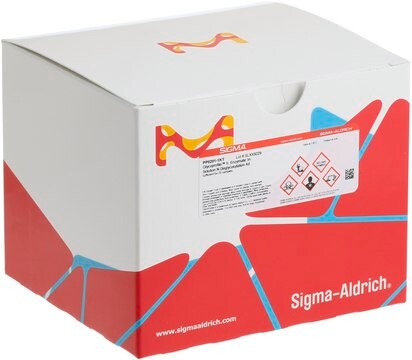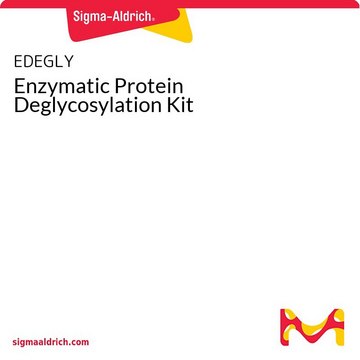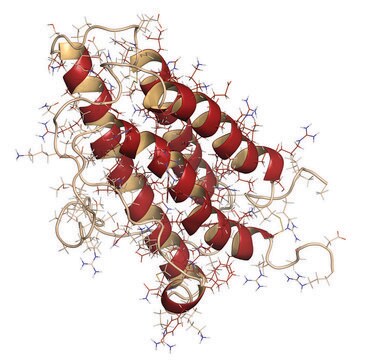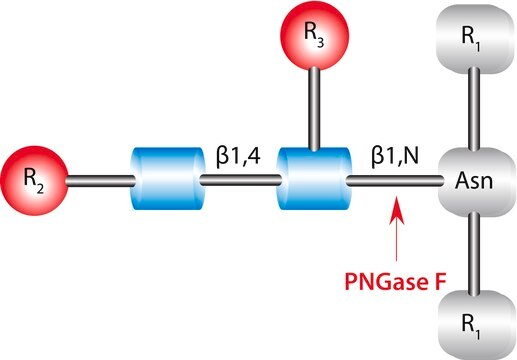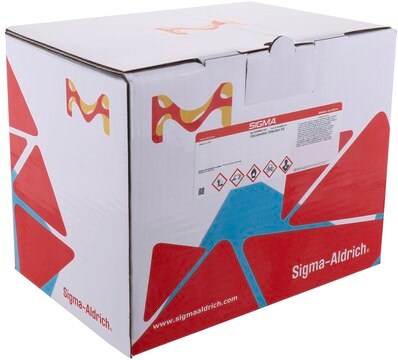362280
Glycoprotein Deglycosylation Kit
Synonim(y):
Zestaw do deglikozylacji
Zaloguj sięWyświetlanie cen organizacyjnych i kontraktowych
About This Item
Kod UNSPSC:
41116133
NACRES:
NA.84
Polecane produkty
producent / nazwa handlowa
Calbiochem®
Poziom jakości
warunki przechowywania
do not freeze
temp. przechowywania
2-8°C
Opis ogólny
Kit contains all enzymes and reagents needed to remove all N-linked, all simple O-linked, and virtually all-complex O-linked oligosaccharides from glycoproteins in a single reaction at neutral pH. Suitable for use with native or denaturation protocols, with no degradation of protein. This kit has been assembled to contain sequencing grade enzymes without azide, BSA, or glycerol. Each kit can be used to deglycosylate up to 2 mg glycoprotein.
Komponenty
Bovine Fetuin Control, Denaturation Solution, Endo-α-N-Acetylgalactosaminidase, β1,4-Galactosidase, Glucosaminidase, N-Glycosidase F, Neuraminidase, Reaction Buffer, TRITON™ X-100 Detergent, and a user protocol.
Ostrzeżenie
Toxicity: Multiple Toxicity Values, refer to MSDS (O)
Charakterystyka techniczna
Assay Time: 3 h-5 days
Inne uwagi
Chiba, A., et al. 1997. J. Biol. Chem.272, 2156.
Jiang, M.S., and Hart, G.W. 1997. J. Biol. Chem.272, 2421.
Wilkins, P.P., et al. 1996. J. Biol. Chem.271, 18732.
Altmann, F., et al. 1995. Glycoconj. J.12, 84.
Szkudlinski, M.W., et al. 1995.
Endocrinology136, 3325.
Pahlsson, P., et al. 1994. Glycoconj. J.11, 43.
Saito, S., et al. 1994. J. Biol. Chem.269, 5644.
Tarentino, A.L., and Plummer, T.H. 1994. Methods Enzymol.230, 44.
Iwase, H., Hotta, K. 1993. Methods. Mol. Biol.14, 151.
Stults, N.L., and Cummings, R.D. 1993. Glycobiology3, 589.
Hard, K., et al. 1992. Eur. J. Biochem.205, 785.
Kuraya, N., and Hase, S. 1992. J. Biochem. (Tokyo)112, 122.
Trimble, R.B., and Tarentino, A.L. 1991. J. Biol. Chem.266, 1646.
Fukuda, M., et al. 1987. J. Biol. Chem.262, 11952.
Sojar, H.T., and Bahl, O.P. 1987. Arch. Biochem. Biophys.259, 52.
Taga, E.M., et al. 1984. Biochemistry23, 815.
Kobata, A. 1979. Anal. Biochem.100, 1.
Uchida, Y., et al. 1979. J. Biochem (Tokyo)86, 1573.
Glasgow, L.R., et al. 1977. J. Biol. Chem.252, 8615.
Spiro, R.G., and Bhoyroo, V.D. 1974. J. Biol. Chem.249, 5704.
Jiang, M.S., and Hart, G.W. 1997. J. Biol. Chem.272, 2421.
Wilkins, P.P., et al. 1996. J. Biol. Chem.271, 18732.
Altmann, F., et al. 1995. Glycoconj. J.12, 84.
Szkudlinski, M.W., et al. 1995.
Endocrinology136, 3325.
Pahlsson, P., et al. 1994. Glycoconj. J.11, 43.
Saito, S., et al. 1994. J. Biol. Chem.269, 5644.
Tarentino, A.L., and Plummer, T.H. 1994. Methods Enzymol.230, 44.
Iwase, H., Hotta, K. 1993. Methods. Mol. Biol.14, 151.
Stults, N.L., and Cummings, R.D. 1993. Glycobiology3, 589.
Hard, K., et al. 1992. Eur. J. Biochem.205, 785.
Kuraya, N., and Hase, S. 1992. J. Biochem. (Tokyo)112, 122.
Trimble, R.B., and Tarentino, A.L. 1991. J. Biol. Chem.266, 1646.
Fukuda, M., et al. 1987. J. Biol. Chem.262, 11952.
Sojar, H.T., and Bahl, O.P. 1987. Arch. Biochem. Biophys.259, 52.
Taga, E.M., et al. 1984. Biochemistry23, 815.
Kobata, A. 1979. Anal. Biochem.100, 1.
Uchida, Y., et al. 1979. J. Biochem (Tokyo)86, 1573.
Glasgow, L.R., et al. 1977. J. Biol. Chem.252, 8615.
Spiro, R.G., and Bhoyroo, V.D. 1974. J. Biol. Chem.249, 5704.
Due to the nature of the Hazardous Materials in this shipment, additional shipping charges may be applied to your order. Certain sizes may be exempt from the additional hazardous materials shipping charges. Please contact your local sales office for more information regarding these charges.
Informacje prawne
CALBIOCHEM is a registered trademark of Merck KGaA, Darmstadt, Germany
Triton is a trademark of The Dow Chemical Company or an affiliated company of Dow
Ta strona może zawierać tekst przetłumaczony maszynowo.
Hasło ostrzegawcze
Danger
Zwroty wskazujące rodzaj zagrożenia
Zwroty wskazujące środki ostrożności
Klasyfikacja zagrożeń
Acute Tox. 3 Dermal - Aquatic Acute 1 - Aquatic Chronic 2 - Eye Dam. 1 - Repr. 2 - Skin Irrit. 2 - Skin Sens. 1
Kod klasy składowania
6.1C - Combustible acute toxic Cat.3 / toxic compounds or compounds which causing chronic effects
Certyfikaty analizy (CoA)
Poszukaj Certyfikaty analizy (CoA), wpisując numer partii/serii produktów. Numery serii i partii można znaleźć na etykiecie produktu po słowach „seria” lub „partia”.
Masz już ten produkt?
Dokumenty związane z niedawno zakupionymi produktami zostały zamieszczone w Bibliotece dokumentów.
Christoph Mück et al.
The journals of gerontology. Series A, Biological sciences and medical sciences, 65(11), 1165-1180 (2010-08-03)
Tumor necrosis factor-like cytokine 1A (TL1A) is expressed in endothelial cells and contributes to T-cell activation, via an extracellular fragment TL1A(L72-L251), generated by ectodomain shedding. Fragments of TL1A, referred to as vascular endothelial growth inhibitor, were found to induce growth
Laura E Brown et al.
The Journal of biological chemistry, 291(27), 13926-13942 (2016-04-30)
The establishment of cell-cell contacts between presynaptic GABAergic neurons and their postsynaptic targets initiates the process of GABAergic synapse formation. GABAA receptors (GABAARs), the main postsynaptic receptors for GABA, have been recently demonstrated to act as synaptogenic proteins that can
Xiaoke Yin 殷晓科 et al.
Arteriosclerosis, thrombosis, and vascular biology, 39(9), 1859-1873 (2019-07-19)
Marfan syndrome (MFS) is caused by mutations in FBN1 (fibrillin-1), an extracellular matrix (ECM) component, which is modified post-translationally by glycosylation. This study aimed to characterize the glycoproteome of the aortic ECM from patients with MFS and relate it to
Nasz zespół naukowców ma doświadczenie we wszystkich obszarach badań, w tym w naukach przyrodniczych, materiałoznawstwie, syntezie chemicznej, chromatografii, analityce i wielu innych dziedzinach.
Skontaktuj się z zespołem ds. pomocy technicznej